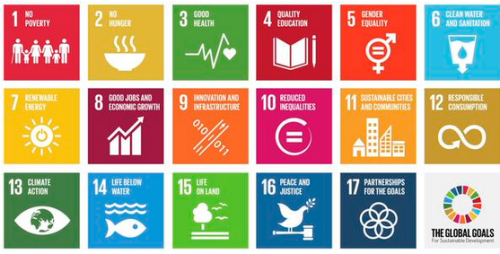Building Capacity for Implementing
the Sustainable Development Goals (SDGs)
 |
Hari Srinivas |
|
Policy Tools Series C-092
|
Abstract:
Capacity-building is a critical enabler for achieving the Sustainable Development Goals (SDGs), as outlined in the 2030 Agenda for Sustainable Development. This text emphasizes the importance of strengthening institutions, fostering technical and scientific cooperation, developing human resources, mobilizing financial resources, and engaging multi-stakeholder partnerships to address sustainability challenges.
By enhancing governance, promoting innovation, and investing in education and training, capacity-building ensures that countries, particularly developing nations, are equipped to implement the SDGs effectively.
Examples such as the Africa Climate Resilient Infrastructure Summit and the Barefoot College Solar Program highlight practical initiatives driving progress. A coordinated, inclusive, and demand-driven approach, supported by international cooperation, is essential for building resilient and sustainable societies capable of meeting the SDG targets by 2030.
Keywords:
Capacity-building, Sustainable Development Goals (SDGs), Institutional strengthening, Multi-stakeholder partnerships, Technical cooperation, Human resource development, Financial mobilization, International collaboration
■ Introduction
 Capacity-building is a fundamental enabler of sustainable development and a critical component of the 2030 Agenda for Sustainable Development. Recognized as a key means of implementation, capacity-building ensures that governments, institutions, and societies are equipped with the necessary knowledge, skills, and resources to achieve the SDGs. Capacity-building is a fundamental enabler of sustainable development and a critical component of the 2030 Agenda for Sustainable Development. Recognized as a key means of implementation, capacity-building ensures that governments, institutions, and societies are equipped with the necessary knowledge, skills, and resources to achieve the SDGs.
Target 17.9 of the SDGs specifically calls for enhanced international support for effective and targeted capacity-building in developing countries, through North-South, South-South, and triangular cooperation. Additionally, capacity-building is emphasized in various international agreements, including Agenda 21, the Johannesburg Plan of Implementation, and the SAMOA Pathway, reinforcing its importance for long-term sustainable development.
■ Key Aspects of Capacity-Building for the SDGs
- Institutional Strengthening and Governance
Strong institutions and effective governance are critical for sustainable development. Institutional strengthening involves improving government structures, policy frameworks, and regulatory mechanisms to facilitate SDG implementation. By fostering transparency, accountability, and participatory governance, institutions can ensure that development efforts are inclusive and aligned with national priorities.
- Strengthening national institutions to ensure effective implementation of the SDGs.
- Enhancing policy coherence and governance frameworks to integrate sustainable development into national priorities.
- Supporting legal and regulatory reforms that facilitate inclusive and sustainable growth.
- Technical and Scientific Cooperation
Technological advancements and scientific research play a pivotal role in driving sustainable development. Facilitating international collaboration in science and technology can enhance innovation, improve resource management, and enable climate-resilient development. Knowledge-sharing between countries allows for the transfer of best practices and innovative solutions to global challenges.
- Promoting knowledge-sharing and the transfer of environmentally sound technologies.
- Enhancing research and innovation to address challenges in climate change, energy, water management, and waste reduction.
- Facilitating partnerships between academic institutions, governments, and the private sector to promote science-driven policies.
- Human Resource Development
Capacity-building also requires investment in human capital. Equipping individuals with the necessary skills, competencies, and expertise is essential for addressing sustainability challenges. Education, training, and leadership development programs ensure that professionals and policymakers are prepared to drive SDG-related initiatives effectively.
- Strengthening education and training systems to develop technical expertise in sustainable development.
- Promoting peer learning and capacity-building workshops to exchange best practices.
- Supporting leadership and management training programs for policymakers and civil society stakeholders.
- Financial and Resource Mobilization
Adequate financial resources are a prerequisite for successful capacity-building efforts. Countries need access to diverse funding sources, including domestic resources, international aid, and private sector investment, to support sustainable development programs. Building financial resilience ensures that SDG initiatives are not hindered by resource constraints.
- Enhancing the ability of countries to mobilize financial resources for sustainable development.
- Providing access to concessional funding and technical assistance for capacity-building initiatives.
- Encouraging investment in sustainable development projects through public-private partnerships.
- Multistakeholder Engagement and Partnerships
Collaboration across different sectors is essential for achieving the SDGs. Effective capacity-building relies on partnerships that bring together governments, businesses, civil society, and international organizations. Engaging diverse stakeholders ensures that solutions are inclusive, context-specific, and scalable.
- Encouraging collaboration between governments, businesses, civil society, and international organizations.
- Strengthening participatory approaches to decision-making and policy formulation.
- Enhancing mechanisms for monitoring and evaluating the effectiveness of capacity-building programs.
■ Multi-Stakeholder Partnerships for Capacity-Building
 Achieving sustainable development requires a collaborative approach that leverages the expertise, resources, and networks of multiple stakeholders. Multi-stakeholder partnerships create synergies between different sectors and enhance the effectiveness of capacity-building initiatives. Achieving sustainable development requires a collaborative approach that leverages the expertise, resources, and networks of multiple stakeholders. Multi-stakeholder partnerships create synergies between different sectors and enhance the effectiveness of capacity-building initiatives.
These partnerships can take various forms, including:
- Public-Private Partnerships (PPPs): Businesses can provide funding, technology, and expertise to support SDG-related initiatives, while governments create enabling environments through policy frameworks and incentives.
- Civil Society Engagement: NGOs and community organizations play a crucial role in mobilizing grassroots efforts, advocating for policy changes, and delivering capacity-building programs at the local level.
- International Cooperation: Global and regional organizations facilitate knowledge exchange, provide technical assistance, and coordinate development efforts across borders.
- Academic and Research Institutions: Universities and think tanks contribute through research, innovation, and specialized training programs that build technical expertise in sustainable development.
By fostering multi-stakeholder partnerships, capacity-building efforts become more comprehensive, resilient, and capable of driving long-term change.
Examples of capacity-building initiatives for the SDGs being implemented in developing countries by various stakeholders:
- Africa Climate Resilient Infrastructure Summit (ACRIS) - Africa
Stakeholders: African Union, UNEP, local governments, private sector
Focus: Strengthening institutional capacity and technical knowledge for climate-resilient infrastructure development in African nations.
- Barefoot College Solar Program - India & Other Countries
Stakeholders: Barefoot College, UNDP, local women's groups
Focus: Training rural women, often grandmothers, as solar engineers to bring renewable energy solutions to off-grid communities.
- SDG Localization in Municipalities - Philippines
Stakeholders: Local governments, UN-Habitat, civil society organizations
Focus: Capacity-building for local governance by integrating the SDGs into municipal planning and budgeting processes.
- One Acre Fund - East Africa
Stakeholders: NGOs, smallholder farmers, agricultural experts
Focus: Providing financial literacy training, technical support, and resources to improve food security and farming productivity.
- Waste-to-Energy Biogas Projects - Bangladesh
Stakeholders: Local businesses, international donors, research institutions
Focus: Converting organic waste into biogas to provide clean energy while promoting waste management and sustainability.
|
■ Implementation Mechanisms
Capacity-building efforts should be structured around demand-driven approaches that respond to the specific needs of countries and communities. Key mechanisms include:
- Workshops and Training Programs: Providing technical expertise, knowledge transfer, and hands-on experience in implementing SDG-related projects.
- Technology and Innovation Platforms: Establishing mechanisms for the exchange of best practices and research findings.
- Policy Advisory Services: Offering tailored support to governments in integrating the SDGs into national development plans.
- Regional and Global Cooperation Frameworks: Strengthening international collaborations through existing UN frameworks, regional organizations, and bilateral agreements.
■ Capacity-Building for Special Situations
Recognizing the unique challenges faced by certain countries, capacity-building efforts must address the needs of:
- Least Developed Countries (LDCs): Focused support for economic diversification, infrastructure development, and institutional capacity.
- Small Island Developing States (SIDS): Enhancing resilience to climate change, sustainable ocean management, and disaster risk reduction.
- Post-Conflict and Fragile States: Rebuilding governance structures, strengthening institutional capacities, and promoting social cohesion.
■ Conclusion
Capacity-building is a cornerstone of sustainable development and an essential enabler for achieving the SDGs. Strengthening institutions, enhancing knowledge-sharing, and fostering international cooperation are critical components of successful capacity-building strategies. By equipping countries with the tools and resources needed to address sustainability challenges, capacity-building ensures that development efforts are impactful, inclusive, and sustainable.
A coordinated approach that integrates financial support, technical expertise, and multi-stakeholder partnerships is essential for driving long-term progress. Governments, international organizations, businesses, and civil society must work together to create an enabling environment for capacity-building.
Through sustained efforts and global collaboration, capacity-building can empower societies to achieve the ambitious targets of the 2030 Agenda and build a more resilient, equitable, and sustainable future for all.
|
 Capacity-building is a fundamental enabler of sustainable development and a critical component of the 2030 Agenda for Sustainable Development. Recognized as a key means of implementation, capacity-building ensures that governments, institutions, and societies are equipped with the necessary knowledge, skills, and resources to achieve the SDGs.
Capacity-building is a fundamental enabler of sustainable development and a critical component of the 2030 Agenda for Sustainable Development. Recognized as a key means of implementation, capacity-building ensures that governments, institutions, and societies are equipped with the necessary knowledge, skills, and resources to achieve the SDGs.
 Achieving sustainable development requires a collaborative approach that leverages the expertise, resources, and networks of multiple stakeholders. Multi-stakeholder partnerships create synergies between different sectors and enhance the effectiveness of capacity-building initiatives.
Achieving sustainable development requires a collaborative approach that leverages the expertise, resources, and networks of multiple stakeholders. Multi-stakeholder partnerships create synergies between different sectors and enhance the effectiveness of capacity-building initiatives.
